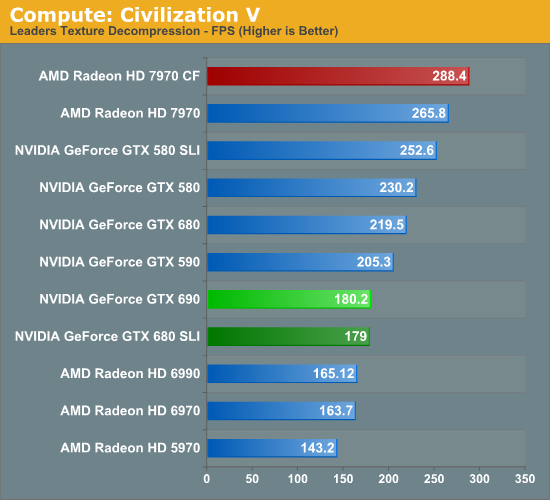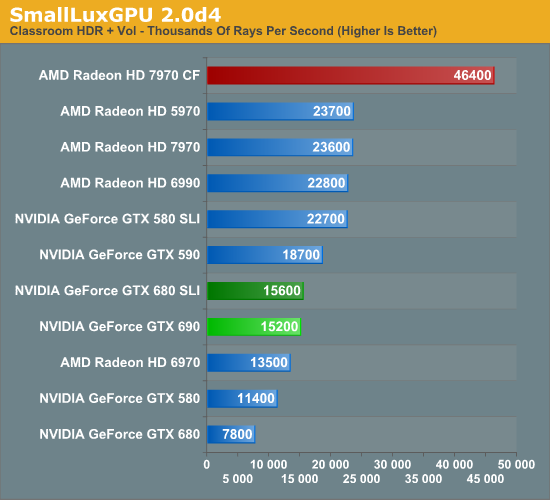NVIDIA GeForce GTX 690 Review: Ultra Expensive, Ultra Rare, Ultra Fast
by Ryan Smith on May 3, 2012 9:00 AM ESTCompute Performance
For our look at compute performance this is going to be a brief look. Our OpenGL AES and DirectCompute Fluid Simulation benchmarks simply don’t scale with multiple GPUs, so we’ll skip though (though the data is still available in Bench).
Our first compute benchmark comes from Civilization V, which uses DirectCompute to decompress textures on the fly. Civ V includes a sub-benchmark that exclusively tests the speed of their texture decompression algorithm by repeatedly decompressing the textures required for one of the game’s leader scenes. Note that this is a DX11 DirectCompute benchmark.

Given the nature of the benchmark, it’s not surprising that we see a performance regression here with some setups. The nature of this benchmark is that it doesn’t split across multiple GPUs well, though that doesn’t stop AMD and NVIDIA from tying. This doesn’t impact real game performance as we’ve seen, but it’s a good reminder of the potential pitfalls of multi-GPU configurations. Though AMD does deserve some credit here for gaining on their single GPU performance, pushing their lead even higher.
Our other compute benchmark is SmallLuxGPU, the GPU ray tracing branch of the open source LuxRender renderer. We’re now using a development build from the version 2.0 branch, and we’ve moved on to a more complex scene that hopefully will provide a greater challenge to our GPUs.

Unlike the Civ V compute benchmark, SLG scales very well with multiple GPUs, nearly doubling in performance. Unfortunately for NVIDIA GK104 shows its colors here as a compute-weak GPU, and even with two of them we’re nowhere close to one 7970, let alone the monster that is two. If you’re looking at doing serious GPGPU compute work, you should be looking at Fermi, Tahiti, or the future Big Kepler.










200 Comments
View All Comments
tviceman - Thursday, May 3, 2012 - link
Last page: Based on our benchmarks we’re looking at 95% of the performance of the GTX "580 SLI" - 580 SLI should read 680 SLI.UltraTech79 - Thursday, May 3, 2012 - link
I wish there was a separate button to point out this sort of thing so they could silently correct it. Dont get me wrong, I think its good to have accurate information, just clutters things up a bit.Ryan Smith - Thursday, May 3, 2012 - link
My inbox is always open.=)mediaconvert - Friday, May 4, 2012 - link
p 2While the basic design of the GTX 690 resembles the GTX 590, NVIDIA has replaced virtually every bit "with plastic with metal" for aesthetic/perceptual purposes.
surely "with plastic with metal" to "of plastic with metal"
still a good review
rockqc - Thursday, May 3, 2012 - link
1st line on page 2 "Much like the GTX 680 launch and the GTX 590 before it, the first generation the first generation of GTX 690 cards are reference boards being built by NVIDIA"First generation has been written twice.
Torrijos - Thursday, May 3, 2012 - link
The first benchmark plotted (Crysis) has a resolution of 5760 x 1200, this has to be wrong!tipoo - Thursday, May 3, 2012 - link
It's crazy but right. He tested that resolution on multiple games.CeriseCogburn - Thursday, May 3, 2012 - link
If you look at accumulated benchmarks across the web, the 680 Nvidia cards beat the 7970 amd cards by a much higher percentage in 1920x1080 (17.61% ahead) than they do in 1920x1200 (10.14% ahead).This means anand reviews always tests in 1920x1200 to give the amd cards a prettier looking review, instead of testing in 1920x1080 (the most commonly available resolution at 1920x that they could easily set their 1920x1200 monitors to).
Hence their tests here at anand are likely also amd favorably biased in higher resolutions.
http://translate.google.pl/translate?hl=pl&sl=...
A5 - Thursday, May 3, 2012 - link
It's not like 19x12 is an uncommon or unavailable resolution. Maybe Nvidia should improve their 19x12 performance?crimson117 - Thursday, May 3, 2012 - link
Sadly, it is a very uncommon resolution for new monitors. Almost every 22-24" monitor your buy today is 1080p instead of 1200p. :(